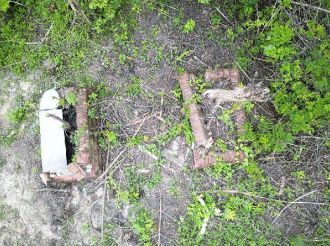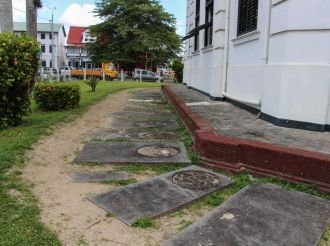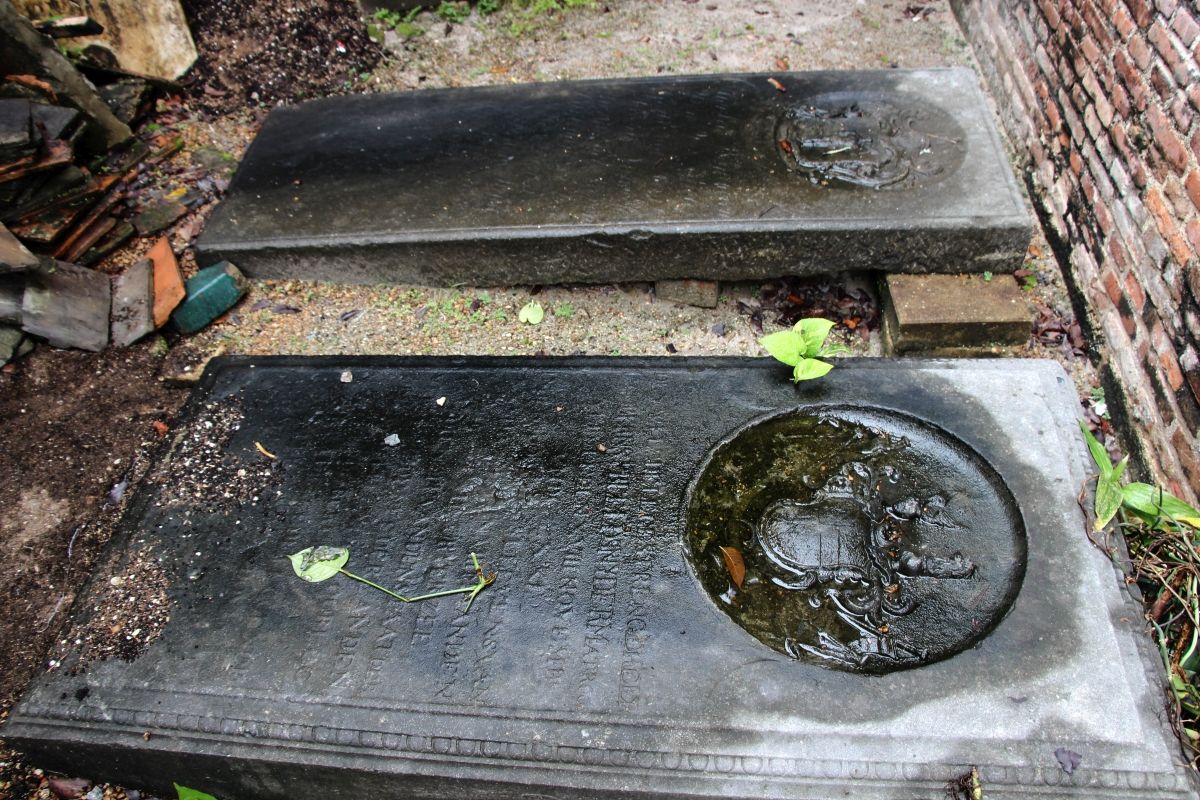
Hodi Mihi Cras Tibi - TRIS collective grave
In various places in Paramaribo, you will find references to fallen soldiers of the Armed Forces in Suriname, or in Dutch “Troepenmacht in Suriname”, TRIS for short. More than forty names are commemorated at a historic location at Fort Zeelandia in Paramaribo. A collective grave of 14 men can be found at the Hodi Mihi Cras Tibi cemetery on the Sophie Redmondstraat in Paramaribo. And then there are several graves in other cemeteries in Suriname, but also a number in the Netherlands. A search for their graves and funerary monuments seems almost impossible, but this article aims to gain an insight.

Plantation Bellevue - Monuments plantation owners
On Thursday 19 May 2022, a team from the Built Heritage Suriname Foundation (SGES) paid a working visit to the Coronie district to inspect and document some historic graves on the Bellevue plantation. The reason for this is the message from Mrs. M. Vroom, that some old graves on the plantation would have been damaged as a result of rehabilitation work on the East-West connection. The SGES team consisted of Rachel Deekman, Jennifer Scheuerman and Stephen Fokké.

Plantage Clyde – Missionary Cemetery Salem Church
The historic graves at the front of the Salem Church at Clyde Plantation in Coronie were partially documented for the first time, in 2003, by Philip Dikland. Of the 18 graves, 8 had been mapped. Two large brick tombs have no headstone, so it is unknown who is buried there. In 2014, Dikland documented another seven graves together with Max van de Poel.

Remains of the old EBGS cemetery Maria's Rust
A few years ago, the historian Mildred Caprino drew the attention of the Suriname Built Heritage Foundation (SGES) to the fact that a tombstone can be found on a plot on the Beter Wonenstraat in Frimangron. Recently we finally went there, where a tombstone was indeed found on an undeveloped lot. The neighbors explained to us that there were actually two tombstones next to each other, one small and one large. However, we only found one, even after an inspection of the site was carried out. The tombstone turned out to be no longer in its original place, as it had been placed on a concrete slab.

Fa Tjauw Koen Sang
The history of a cemetery for Chinese residents of Paramaribo goes back to the late nineteenth century. Just before the turn of the century, the Kong Ngie Tong Association established a final resting place for the Chinese community. People would be buried there for over forty years.

Brief history of the Orange garden
Initially, the dead were buried in and near Fort Zeelandia, especially the senior officers and civil servants. With the arrival of a middle class, there was also a need for a suitable church and a cemetery.

The first Dutch burials in Paramaribo
The death rate among Europeans was high in the tropics. The Briton Stedman was employed by the Republic as captain of a corps of volunteers sent to Suriname to quell an uprising of runaway slaves. In 1773 he was in Paramaribo and wrote the following:
Op deezen tijd woedden ‘er veele ziekten onder ons scheepsvolk; bijna elken dag wierden ‘er viif of zes matroozen van de koopvaardij-schepen begraaven. Het lot van deeze soort van mensen is in dit land over het algemeen zeer slegt; […] Zij stillen hunnen honger met enige bananen en pisangs, eeten oranjen en drinken water, hetgeen hen welhaast van alle kwaad verlost, door hen naar de eeuwigheid te zenden. Duizenden worden op deeze wijze in het graf gestort, die, volgens den gewoonen loop hunnes levens, nog veele jaaren zouden hebben kunnen tellen. [1]


